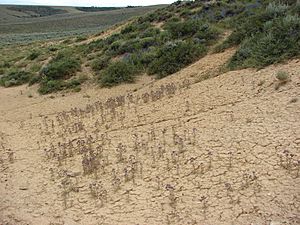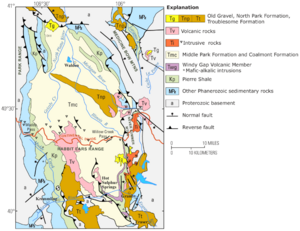Coalmont Formation facts for kids
Quick facts for kids Coalmont FormationStratigraphic range: Paleocene-Wasatchian ~60–50Ma |
|
|---|---|

Coalmont Formation, Jackson County, Colorado
|
|
| Type | Formation |
| Underlies | North Park Formation |
| Overlies | Cretaceous strata |
| Thickness | 9,000 feet (2,700 m) |
| Lithology | |
| Primary | Sandstone |
| Other | Clay, Shale, Coal |
| Location | |
| Coordinates | 40°24′N 106°30′W / 40.4°N 106.5°W |
| Approximate paleocoordinates | 45°00′N 90°18′W / 45.0°N 90.3°W |
| Region | Colorado |
| Country | |
| Extent | North Park intermountaine basin |
| Type section | |
| Named for | Coalmont, Jackson County, Colorado |
| Named by | A. L. Beekly |
The Coalmont Formation is a special type of rock layer found in the North Park basin in Colorado. It's like a giant history book made of stone. This formation holds amazing clues about Earth's past.
Scientists have found many fossils of ancient plants and layers of coal here. These finds tell us about a time called the Paleogene period. This period was about 60 to 50 million years ago.
Contents
Discovering Ancient Life in Coalmont
The Coalmont Formation is famous for its fossils. These fossils help us understand what life was like millions of years ago. Imagine finding plants and insects that lived when dinosaurs were just gone!
Fossil Insects
Scientists have found several types of ancient insects in the Coalmont Formation. These tiny fossils give us a peek into the insect world of the past. They include:
- Calandrites hindsi
- ?Calandrites ursorum
- ?Carabites arapahoensis
- Curculio beeklyi
- Ophryastites hendersoni
Fossil Plants (Flora)
The Coalmont Formation is especially rich in plant fossils. These fossils show us the kinds of forests and plants that grew here long ago. Many of these plants are related to trees and shrubs we see today. Some of the plant fossils found are:
- Allantodiopsis erosa
- Ampelopsis acerifolia
- Betula stevensoni
- Carya antiquorum
- Cercidiphyllum arcticum
- Cissus marginata
- Eucommia serrata
- Fraxinus eocenica
- Glyptostrobus nordenskioldi
- Hydromystria expansa
- Lastrea goldiana
- Laurophyllum perseanum
- Laurus socialis
- Lygodium coloradense
- Metasequoia occidentalis
- Mimosites coloradensis
- Nordenskioldia borealis
- Persea brossiana
- Platanus nobilis
- P. raynoldsi
- Prunus corrugis
- Pterocarya hispida
- Quercus greenlandica
- Q. sullyi
- ?Robinia wardi
- Sassafras thermale
- Sparganium antiquum
Connecting with Other Ancient Sites
The Coalmont Formation is part of a larger geological time period called the Wasatchian age. This age is important for understanding how life changed across North America. Scientists compare fossils from the Coalmont Formation with those found in other rock layers from the same time. This helps them learn about ancient environments and how animals and plants spread.
For example, fossils like Coryphodon (an ancient mammal) and Paramys (an early rodent) have been found in the Coalmont Formation. They are also found in other formations like the Wasatch Formation and Willwood Formation. This shows that similar animals lived in different parts of North America during the Wasatchian age.
The table below shows some of the animals and plants found in the Coalmont Formation and other places during the Wasatchian age. It also shows if the area had volcanic activity or was a river, lake, or ocean environment.
| Formation | Wasatch | DeBeque | Claron | Indian Meadows | Pass Peak | Tatman | Willwood | Golden Valley | Coldwater | Allenby | Kamloops | Ootsa Lake | Margaret | Nanjemoy | Hatchetigbee | Tetas de Cabra | Hannold Hill | Coalmont | Cuchara | Galisteo | San Jose | Ypresian (IUCS) • Itaboraian (SALMA) Bumbanian (ALMA) • Mangaorapan (NZ) |
|---|---|---|---|---|---|---|---|---|---|---|---|---|---|---|---|---|---|---|---|---|---|---|
| Basin | Powder River Uinta Piceance Colorado Plateau Wind River Green River Bighorn |
Piceance |
Colorado Plateau |
Wind River |
Green River |
Bighorn |
Williston | Okanagan | Princeton | Buck Creek | Nechako | Sverdrup | Potomac | GoM | Laguna Salada | Rio Grande | North Park | Raton | Galisteo | San Juan | ||
| Country | ||||||||||||||||||||||
| Copelemur | ||||||||||||||||||||||
| Coryphodon | ||||||||||||||||||||||
| Diacodexis | ||||||||||||||||||||||
| Homogalax | ||||||||||||||||||||||
| Oxyaena | ||||||||||||||||||||||
| Paramys | ||||||||||||||||||||||
| Primates | ||||||||||||||||||||||
| Birds | ||||||||||||||||||||||
| Reptiles | ||||||||||||||||||||||
| Fish | ||||||||||||||||||||||
| Insects | ||||||||||||||||||||||
| Flora | ||||||||||||||||||||||
| Environments | Alluvial-fluvio-lacustrine | Fluvial | Fluvial | Fluvio-lacustrine | Fluvial | Lacustrine | Fluvio-lacustrine | Deltaic-paludal | Shallow marine | Fluvial | Shallow marine | Fluvial | Fluvial |
|
||||||||
| Volcanic | Yes | No | Yes | No | Yes | No | Yes | No | Yes | No | ||||||||||||


